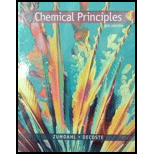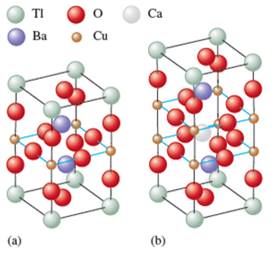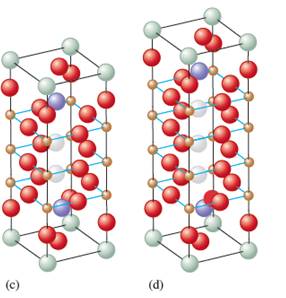
(a)
Interpretation: The formula of the four superconductors needs to be determined.
Concept Introduction: The superconductor is a substance which is capable of superconducting at very low temperature values.
(a)
Explanation of Solution
The given structures are as follows:


By considering the color code for spheres, the number of atoms of each element can be counted.
It can be observed that in molecule (a) there is 1 Tl, 2 Ba, 1 Cu and 5 O atoms in 1unit. Thus, the formula of the molecule will be:
Similarly, the atoms in molecule (b) are 1 Tl, 2 Ba, 1 Ca, 1 Cu and 7 O in 1unit. Thus, the formula will be:
The structure (c) contains 1 Tl, 2 Ba, 2 Ca, 3 Cu and 9 O atoms in 1unit. The formula will be:
Similarly, the structure (d) has 1 Tl, 2 Ba, 2 Ca, 4 Cu and 11 O atoms in 1unit thus, the molecular formula will be:
(b)
Interpretation: The four structures needs to be ordered from lowest to highest superconducting temperature.
Concept introduction: The number of sheets in the unit cell is directly proportional to the temperature for the superconductivity.
(b)
Explanation of Solution
If the number of sheets in each unit cell increases, the temperature for the superconductivity increases. The number of sheets in the structure (a) is less then (b) which is further less than (c) and (d). Thus, the increasing order of the superconductivity for 4 structures will be as follows:
(c)
Interpretation: The oxidation state needs to be assigned to Cu in each mixture. It is assumed that the oxidation state of Tl is +3. Also, the oxidation state of Ca, Ba, O is +2, +2 and -2 respectively.
Concept Introduction: The oxidation state of any atom in the molecule is equal to the charge on it. It can be calculated if oxidation state of all the other atoms is given.
For example, the molecule H2O2 is neutral. The oxidation state of H is +1 (general) thus, the oxidation state of O can be calculated as follows:
Thus, the oxidation state of O in H2O2 is -1.
(c)
Explanation of Solution
The oxidation state of Cu in structure can be calculated by taking the overall charge on the molecule equal to zero.
The oxidation state of Tl, Ca, Ba and O is assumed +3, +2, +2 and -2 respectively.
For
Thus, the oxidation state of Cu in molecule (a) is +3.
For
There are 2 Cu atoms, thus, there is a mixed oxidation state one is
For
Thus, copper has mixed oxidation state that is 1
For
There will be one
(d)
Interpretation: The reason for the copper to display a mixture of oxidation states in the superconductor needs to be explained.
Concept Introduction: The superconductor is a substance which is capable of superconducting at very low temperature values.
(d)
Explanation of Solution
There are variable oxidation states of copper due to varying the numbers of Ca, Cu and O atoms in each unit cell. The different oxidation states of Cu are calculated for molecules (b), (c) and (d). In the other superconductor in exercise 79, in YBa2Cu3O7, there is variable oxidation state of copper by omitting oxygen atom at various sites in the lattice.
Want to see more full solutions like this?
Chapter 16 Solutions
CHEM.PRINC.W/OWL2+REBATE+2 SUPPL.>IP<
- The structures of another class of ceramic, high-temperature superconductors are shown in figures a-d. a. Determine the formula of each of these four superconductors. b. One of the structural features that appears to be essential for high-temperature superconductivity is the presence of planar sheets of copper and oxygen atoms. As the number of sheets in each unit cell increases, the temperature for the onset of superconductivity increases. Order the four structures from lowest to the highest superconducting temperature. c. Assign oxidation states to Cu in each structure assuming Tl exists as Tl3+. The oxidation states of Ca, Ba, and O are assumed to be + 2, + 2, and 2, respectively. d. It also appears that copper must display a mixture of oxidation states for a material to exhibit superconductivity. Explain how this occurs in these materi.als as well as in the superconductor in Exercise 87.arrow_forwardWhich solid phase that is, which allotrope of carbon is more stable, graphite or diamond? You should consult some of the tables in the thermodynamics section of this text.. Both solid phases exist under normal conditions of pressure and temperature. Explain why this is so, given that one solid phase is more thermodynamically stable than the other. Do their unit cells provide any suggestion for their relative stabilities?arrow_forwardWhat is the percent by mass of titanium in rutile, a mineral that contains titanium and oxygen, if structure can be described as a closest packed array of oxide ions with titanium ions in one-half of the octahedral holes? What is the oxidation number of titanium?arrow_forward
- Consider the three types of cubic units cells. (a) Assuming that the spherical atoms or ions in a primitive cubic unit cell just touch along the cubes edges, calculate the percentage of occupied space within the unit cell. (Recall that the volume of a sphere is (4/3)r3, where r is the radius of the sphere.) (b) Compare the percentage of occupied space in the primitive cell (pc) with the bcc and fcc unit cells. Based on this, will a metal in these three forms have the same or different densities? If different, in which is it most dense? In which is it least dense?arrow_forwardThe free space in a metal may be found by subtracting the volume of the atoms in a unit cell from the volume of the cell. Calculate the percentage of free space in each of the three cubic lattices if all atoms in each are of equal size and touch their nearest neighbors. Which of these structures represents the most efficient packing? That is, which packs with the least amount of unused space?arrow_forwardThe structure of graphite is given in Figure 12.19. (a) What type of intermolecular forces exist between the layers of six-member carbon rings? (b) Account for the lubricating ability of graphite. That is, why does graphite feel slippery? Why does pencil lead (which is really graphite in day) leave black marks on paper?arrow_forward
- A compound containing zinc, aluminum, and sulfur crystallizes with a closest-packed array of sulfide ions. Zinc ions are found in one-eighth of the tetrahedral holes and aluminum ions in one-half of the octahedral holes. What is the empirical formula of the compound?arrow_forwardGold crystallizes in a face-centered cubic unit cell. The second-order reflection ( n=2) of X-rays for the planes that make up the tops and bottoms of the unit cells is at =22.20. The wavelength of the X-rays is 1.54 A. What is the density of metallic gold?arrow_forward
 ChemistryChemistryISBN:9781305957404Author:Steven S. Zumdahl, Susan A. Zumdahl, Donald J. DeCostePublisher:Cengage Learning
ChemistryChemistryISBN:9781305957404Author:Steven S. Zumdahl, Susan A. Zumdahl, Donald J. DeCostePublisher:Cengage Learning Chemistry: An Atoms First ApproachChemistryISBN:9781305079243Author:Steven S. Zumdahl, Susan A. ZumdahlPublisher:Cengage Learning
Chemistry: An Atoms First ApproachChemistryISBN:9781305079243Author:Steven S. Zumdahl, Susan A. ZumdahlPublisher:Cengage Learning
 Chemistry & Chemical ReactivityChemistryISBN:9781337399074Author:John C. Kotz, Paul M. Treichel, John Townsend, David TreichelPublisher:Cengage Learning
Chemistry & Chemical ReactivityChemistryISBN:9781337399074Author:John C. Kotz, Paul M. Treichel, John Townsend, David TreichelPublisher:Cengage Learning Chemistry & Chemical ReactivityChemistryISBN:9781133949640Author:John C. Kotz, Paul M. Treichel, John Townsend, David TreichelPublisher:Cengage Learning
Chemistry & Chemical ReactivityChemistryISBN:9781133949640Author:John C. Kotz, Paul M. Treichel, John Townsend, David TreichelPublisher:Cengage Learning Physical ChemistryChemistryISBN:9781133958437Author:Ball, David W. (david Warren), BAER, TomasPublisher:Wadsworth Cengage Learning,
Physical ChemistryChemistryISBN:9781133958437Author:Ball, David W. (david Warren), BAER, TomasPublisher:Wadsworth Cengage Learning,





